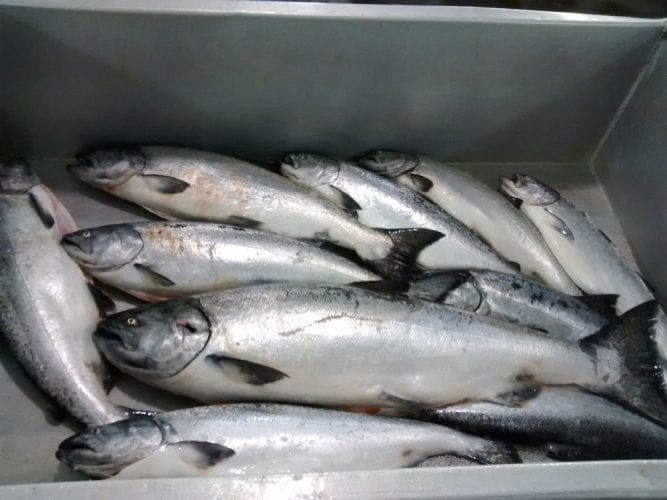
Management numbers for king salmon in Southeast Alaska are up slightly from last year but will mean similar conservation measures to protect low returns to the region’s rivers.
The Alaska Department of Fish and Game Monday, April 1 announced the all-gear harvest limit for chinook at 137,500. That number is set under the Pacific Salmon Treaty agreement and based on commercial trolling catch rates during the early winter season near Sitka.
Most of that, or 101,300 kings, goes to the commercial troll fleet. That’s an increase over last year’s troll allocation by 5600 chinook.
Some 25,300 fish are allocated to the sport fishing fleet and the remainder are caught in commercial net fisheries.
Fish and Game is also announcing the second year of conservation measures to reduce Alaska’s catch of kings returning to the Chilkat, Taku, Stikine and Unuk and other rivers. Those will mean very limited commercial trolling in the springtime. And some areas will remain closed to trollers in their first summer opening as well.
Gillnetters will see delays to the start of their season and mesh restrictions in some areas to reduce king salmon catches. And purse seiners will not be able to keep kings again, at least for the first part of the summer.
The sport fishing allocation means a one-fish resident bag limit. Non-resident anglers also have a one-fish bag limit along with an annual limit of three kings. Meanwhile, sport fishing for kings on most of the inside waters of the region is closed in April and May and in some cases into July.
Commercial salmon trollers in Southeast Alaska have finished their winter season at just above the total catch from last year
The season was shortened for the second year in a row, in an effort to protect king salmon returning to rivers in Southeast.
The final numbers are expected to change a little as additional catches are reported but the total catch for the season so far is around 12,400 chinook. That’s up around 400 fish from last year.
Rhea Ehresmann is assistant troll management biologist with the Alaska Department of Fish and Game. She says catch rates were very similar to last year, but up slightly, from six fish per landing to seven fish per landing this year.
“Sitka, Yakutat and Frederick Sound areas had the greatest total harvest in the region for the winter troll fishery,” Ehresmann said. “Overall the catch rates were similar to last year with a bit more harvest occurring in Yakutat. So maybe that’s where you’re seeing this pick up in harvest.”
The total catch is well below long term averages, even accounting for the shortened season. The effort was also down. Some 262 permit holders fished in the winter, down around 70 from last year. And prices were again in record territory.
“So it finished about 50 cents higher than last year,” Ehresmann said of this year’s price. “This year the average price was 11 dollars and 83 cents per pound,” she said. “And the average weight for a winter king was 11.7 pounds.”
That’s one bright spot. That average size is up about a half pound from last year. And the number of kings from Alaska hatcheries was up this winter, making up 13 percent of the catch, more than double last year.
Ehresmann said like last year, some limited springtime commercial trolling is expected around hatchery returns in May and June.
“We’re still finalizing our plans for the spring fisheries but overall our spring fisheries will be again quite similar to what we saw last year, with some spring areas opening initially May 1st and more areas opening in June as we see more Alaska hatchery fish showing up,” Ehresmann said.
Fish and Game is expecting to announce more information about spring trolling this month.











